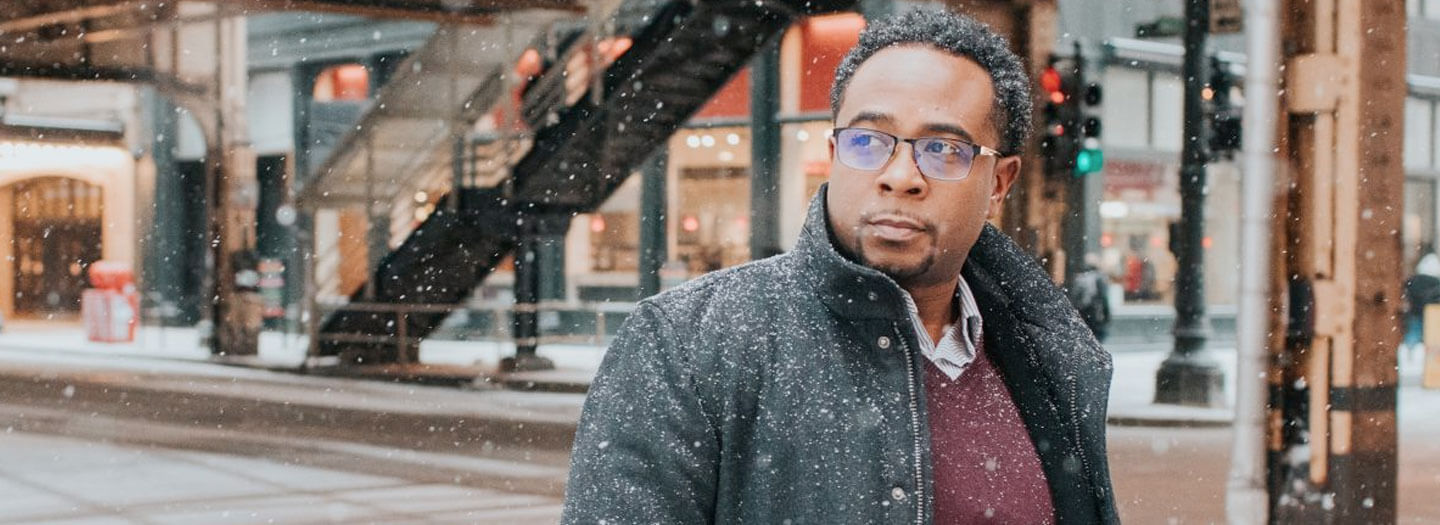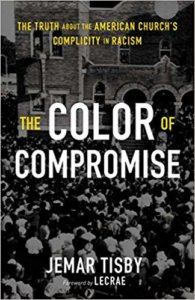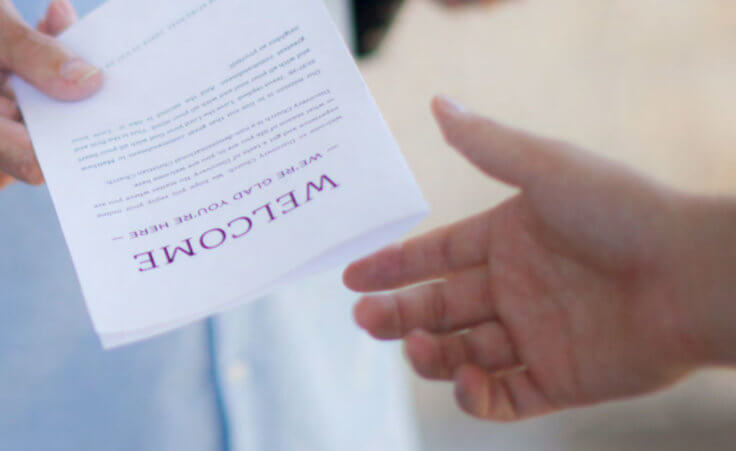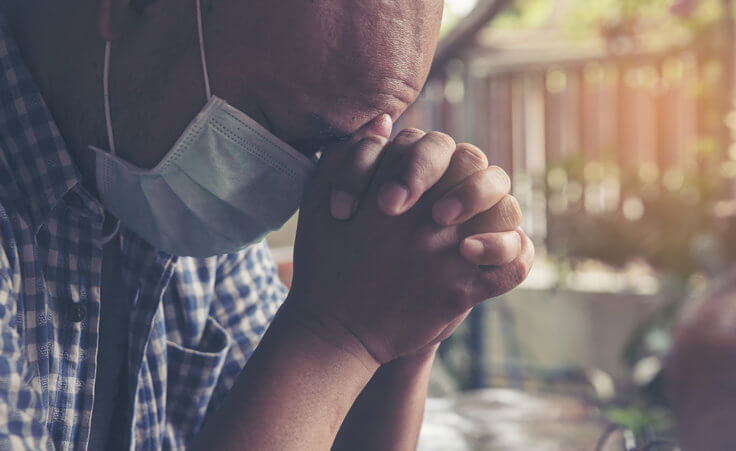
Jemar Tisby vis JemarTisby.com
Christian historian, writer, and speaker Jemar Tisby joined us for an interview about his first book, The Color of Compromise: The Truth about the American Church’s Complicity in Racism, which was released in January of 2019.
The following article is adapted and excerpted from our full podcast interview with Jemar Tisby, embedded above, and conducted by Denison Forum’s Katharine Elkins. Portions have been edited for clarity and conciseness.
Tisby is currently writing his dissertation as part of the PhD program in history at the University of Mississippi. He serves as president of The Witness, a black Christian collective that engages issues of religion, race, justice, and culture from a biblical perspective, and he’s the cohost of its podcast, Pass The Mic.
He grew up in the Chicago area and became a Christian at the age of sixteen through a youth group. He went to Notre Dame (although he has never been Catholic), spent a semester in Jerusalem, and stayed an extra year at Notre Dame to work in campus ministry.
He joined Teach for America and taught sixth grade for four years at a public charter school in the Mississippi Delta. He then went to Reformed Theological Seminary in Orlando for a year. Then God called him back to his former school to be principal for three years. In June of 2011, he moved to Jackson, Mississippi, to finish his MDiv at RTS Jackson. He has a wife and a son.
Why did you write The Color of Compromise?
I moved to Jackson, Mississippi, to do a Masters in Divinity. After that, I was looking at getting a PhD somewhere. Initially, I was looking into theology and seminary programs, but I knew I needed more background because I wanted to do something involving race and African American history and whatnot.
I took a graduate course in history at Jackson State University, which is an historically black college in Jackson, Mississippi. I read some incredible books, which I would recommend: John Dittmer’s Local People, Charles Payne’s I’ve Got the Light of Freedom, and Fitzhugh Brundage’s Lynching in the New South. Those books opened my eyes . . . to the depth of racism, not just in the South, but nationwide.
Along with that, as I’m learning this history in detail for the first time in my adult life, things are happening nationally.
In August of 2014, Mike Brown is shot and killed by a white police officer, which sparks the Black Lives Matter movement and also a national conversation about race and justice. If you track the contours of that conversation, black and white Christians often did not see eye-to-eye and often did not agree—not just about that incident in Ferguson, but on racial and justice issues in general.
For me, that highlighted the continuing divide . . . that race and racism—and misunderstandings about those topics—generate, not only nationally, but also within the church.
Speed forward: I enroll in the PhD program in history at the University of Mississippi.
As part of the coursework, I’m reading dozens and dozens of books about US history, on every topic. But, again and again, racism comes up. And, if the church is mentioned, I often saw [how] the church is on the wrong side of that history.
I’ve got this flood of emotions. There’s anger, there’s a lament, and there’s urgency. So why did I write the book? All of those reasons.
As I’m learning the history, I want to share it with people because very few people have the opportunity to enroll in a graduate program and sit down and study this . . . . Also, I really want to spur the church and Christians to action because what happened with me is, once I started learning that history . . . which is really brutal—it’s violent, it’s bloody, there’s bigotry and hatred. There’s missed opportunities all around.
I wanted to do something about it. And so that’s my hope with the book: when people of faith read this, when they learn the details of the history, when they see just how bad it was, it would be yet another reason to take immediate action for racial justice.
Why did you call it The Color of Compromise?
The original draft was going to be called The Fierce Urgency of Now, a phrase from Martin Luther King Jr.’s “I have a dream” speech.
Now, a lot of us remember that speech for the part where he talks about his children not being judged by the color of their skin but by the content of their character. And that’s wonderful.
But, if you go back and listen to or read the beginning of this speech, he’s really fired up. They’ve come to Washington in the March on Washington for jobs and freedom. America has not cashed this promissory check—it’s come back [with] insufficient funds in terms of justice for black people and other people of color.
So he talks about this idea of the fierce urgency of now, where people want to promote this idea of gradualism and just wait a little longer and it’ll change. He’s like, “It’s been centuries. How much longer should we wait? We need to respond to the fierce urgency of now.”
Even now, sixty years later, you could still say that when it comes to racial justice, we need to respond to the fierce urgency of now. So that ended up being the title of the last chapter.
But the title of the book, The Color of Compromise, really gets at the entire theme throughout the book. It’s a historical survey from the colonial era on up to the present. I try to show how, in each historical period of US history, Christians compromised with racism instead of confronting it.
We tend to think of racism in the most extreme forms: It’s the people who do lynchings, who burn crosses and put on white robes and hoods. It’s the people who say the N-word and all of this stuff. Those are the real racists. Well, the problem with that is quantitatively, numerically, that’s actually a pretty small number of people. They do huge damage, but it’s not the majority of people—certainly not the majority of Christians.
So what were the majority of Christians doing?
They were demonstrating compromise and complicity. How? Through inaction. Through passivity. Through silence. Through apathy.
It’s not just what they did, it’s what they didn’t do. And so The Color of Compromise is about how Christians fail to confront this status quo.
If I could just tell a quick story from the opening of the book: I talk about the 16th Street Baptist Church bombing in Birmingham, Alabama, in 1963. Most people remember this: four little girls were killed in this act of racial terrorism.
And it was absolutely horrifying. Even segregationists decried this act of violence. I mean, what could be more innocent than young girls in church getting killed because of racism, right?
There was a young lawyer in Birmingham, a white lawyer named Charles Morgan, Jr. He had been scheduled to give a talk in front of the Young Men’s Business Association in Birmingham that week, the same week as the bombing. He went on with his talk as scheduled, but he tweaked the topic in light of this international tragedy.
He asked this group of young white powe brokers in town, “Who did it? Who threw that bomb? Was it a Negro or a white?” And he tells his audience the answer: “Should it be all of us? All of us did it.” Then he goes through all of the ways that his friends, his peers, and he himself had failed to confront racism and acts of racial terrorism in Birmingham prior to that bombing.
The town already had the nickname Bombingham. There was already a neighborhood nickname, Dynamite Hill. This was not the first time. Then he turns his attention to the church and says, “How many of us visited the Negroes in their hour of travail? Do we even let them join our churches?”
And so what Charles Morgan, Jr.was demonstrating was this idea of complicity. It wasn’t any of the people in that room who actually planted the dynamite, but it was by what they didn’t do, or what they didn’t say, or how they failed to act. That created the context of compromise where such an act of racial terrorism can occur.
That’s kind of the point I try to make throughout the book: throughout US history, it’s not necessarily all the things that Christians did. Certainly Christians—particularly white Christians in the American church—did a lot of racist stuff. But it’s also by failing to confront it or by compromising with it that helps create a racial society.
What do Christians need to do to improve race relations today?
There’s a whole lot, but the book is really a setup to get you to the last chapter, which is precisely about your question. That last chapter, called The Fierce Urgency of Now, outlined some practical ways that Christians can confront racism instead of being complicit with it.
I will say that I focus more on the broader institutional, systemic, society-wide actions we can take. Because, as important as it is to develop cross-cultural friendships and relationships, all the cups of coffee in the world aren’t going to do a thing about mass incarceration. All of the pulpit swaps in the world aren’t going to close the racial wealth gap. And so we have to look more broadly than that.
But instead of just giving specific suggestions, what I do, in addition to that, is give you a framework. I talk about something called the arc of racial justice: it stands for awareness, relationships, commitment.
These are three broad categories we need to keep in mind if we want to make significant progress on racial justice. This is not a linear process. You move from awareness to relationships to commitment. They’re all happening at the same time.
It’s also not a terminal process to where you get finished. [You are] constantly growing in this. But awareness is simply gaining more information about race and racism. History and information have never been more accessible. There are documentaries, books, conferences, and podcasts where you can increase your knowledge and awareness of racism. [You’ve] got to know how it’s working, how it has worked, what it looks like now.
Fundamentally, all reconciliation is relational.
When God wanted to reconcile himself with humanity, he didn’t send a tweet or a blog post, he sent his son. The idea is that you have a relationship with a person, Jesus. And that restores your relationship with God, but it also allows you to restore our relationship with each other. So relationships are key.
The problem is, oftentimes, we stop at relationships. We think, Well, I am a nice person. Some of my best friends are black or brown or whatever. I have cross-cultural friendships so I’m doing my part to eradicate racism. Yeah, keep doing that, but go for it. That’s the commitment part. It’s a commitment to action specifically. It’s recognizing that inequality is based in policies. It’s based in laws that continue to create or perpetuate racial divides. And so Michelle Alexander’s great book, The New Jim Crow, shows that, even in sentencing laws for drug offenses, there was a disparity.
So there are subtle ways that maybe never use the words black or white or race in the policy, but it still has an unequal impact and a disproportionately negative impact on people of color and the poor. So Christians need to also look at the policy level if we want to fight racism.
For more on The Color of Compromise
To hear more from Jemar Tisby, listen to “Racial injustice and the fierce urgency of now: A conversation with Jemar Tisby, author of The Color of Compromise,” a bonus episode of The Daily Article Podcast.
In addition to the questions above, Tisby also answers how he became a Christian, how he can love the Deep South despite its troubled racial history, how Christians perpetuated racism in colonial times, and how there would be no black church without racism in the white church.
You can read the first chapter of The Color of Compromise.
Tisby also has a twelve-episode video teaching series through The Color of Compromise available on Amazon.












